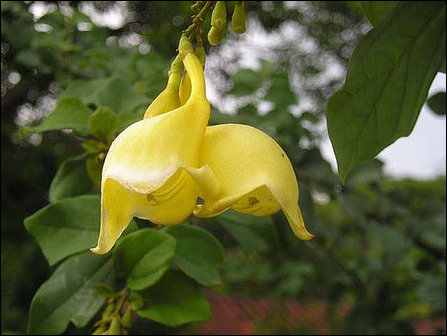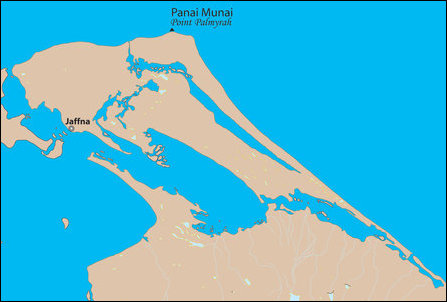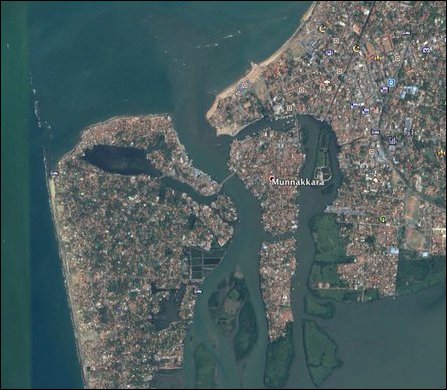Know the Etymology: 165
Place Name of the Day: Tuesday, 25 April 2017
Kumuḻa-muṉai, Kaṟukkāy-muṉai, Toṭa-muṇa, Goḍa-munna, Munnak-karē
குமுழமுனை, கறுக்காய்முனை, தொ[ட்]டமுண, கொ₃ட₃முன்ன, முன்னக்கரே
Kumuḻa-muṉai, Kaṟukkāy-muṉai, Toṭa-muṇa, Goḍa-munna, Munnak-karēKumuḻam+muṉai
Kaṟukkāy+muṉai
Toṭa+muṇa
Goḍa+munna
Munna+karē
The headland found with Kumiḻ trees
The seafront found with Kaṟukkāy trees
The ferry front or harbour front
The edge or front of the high ground
The seashore at the mouth or the neighbourhood of the point
| Muṉai | front, face, point, eminence, sharpened end, edge, cape, headland (Tamil, DED 5020a); place (Tamil, Caṅkam diction, Naṟṟiṇai, 270: 4); Muṉ: in front, prior, eminence, a sign of the locative (Tamil, DED 5020a); locative affix (Tamil, Naṟṟiṇai, 2: 7); Muṉṉu, Muṉṉi: (verb) to look in front, reach, meet, precede (Tamil, DED 5020a, Kuṟuntokai, 352: 3); cognates in 18 Dravidian languages, including Brahui of Pakistan. See boxes on Muna and Muṇa in Sinhala |
| Muna | end, top, extremity, tip, point, (Sinhala, Clough); "Ula, Tuḍa, Uḍa-pẹtta" (Sinhala, Sorata); Muṉai: front, face, point, eminence, sharpened end, edge, cape, headland (Tamil, DED 5020a). See box on Muṉai in Tamil |
| Muṇa | 1.= Muhuṇa, Mūṇa: face, side, direction, "Mukhaya, Pẹtta, diśāva" (Sinhala, Sorata); Mukam, Mukaṉ: face, mouth (Tamil, DED 4889, Akanāṉūṟu, 86: 28); Mukaṉai: forepart, front (Tamil, DED 4889); Muguṇu: the front (Tulu, DED 4889); Mūñci: face (Tamil, DED 5031); Mūññi: face (Malayalam DED 5031); Mōṇē: face (Tulu, DED 5031); Mūṇu: face (Dhivehi/ Maldivian, DBF); Muṇa, Muṇan, Muńña: tip, point, extreme position of land (usage in Maldivian island names, EDMIN); 2. = Muna: point, tip; "Tuḍa, Ula" (Sinhala, Sorata); see box on Muṉai in Tamil |
| Munna | also Munē: toponymic forms of Muna or Muṇa; a ground that makes a front (Sinhala place names). See boxes on Muṉai in Tamil and Muna/ Muṇa in Sinhala |
| Kumuḻ | variation of Kumiḻ: small cashmere tree, Gmelina asiatica (Tamil, MTL, DED 1742, Tamil Brahmi inscription, ETE 49); Peruṅ-kumiḻ, coomb teak, Gmelina arborea (Tamil, MTL, DED 1742); Gmelina tomentosa (Tamil, Winslow); Gmelina asiatica (Malayalam, DED 1742); knob (Tamil, Malayalam, DED 1743); anything round or convex (Tamil, MTL); the tree got the name from its Kumiḻ-shaped flower; in old poetry a shapely feminine nose was often compared to this flower (Tamil, Winslow, Naṟṟiṇai, 6: 7); Kumiḻ: (verb) to grow into a conical shape, to be spherical (Tamil, MTL); Kumi: (verb) to be heaped up (Tamil, DED 1741); Komul: Gmelina asiatica, "Demaṭa" (Sinhala, Sorata, Clough, App.); Demaṭa: commonly used Sinhala term for Gmelina asiatica (Sinhala, Clough); Demaṭa could have come from comparing the flower to a kind of ear ornament; such a comparison is also noticed in old literature (Naṟṟiṇai, 286, 1-2); Maṭṭa: round ornament for the ear (Sinhala, Clough; the De prefix comes for things considered as a pair) |
| Kaṟukkāy | = Kaṭukkāy, Kaṭu: chebulic myrobalan, Terminalia chebula (Tamil, MTL, DED 1134, Malaipaṭukaṭām, 14); Karaka, Karakkāya: Terminalia chebula (Telugu, DED 1134); Karka: Terminalia chebula (Parji, Gondi, Konda, Kuwi, DED 1134) |
| Toṭa | ford, ferry, riverbank, port, harbour, (Sinhala, Clough, Sorata). See column 166 |
| Goda | bank, hill, village, (Sinhala, Sorata). See column 160 |
| Karē | from Kara, Karā: seashore, neighbourhood (Sinhala, Sorata). See column 353 |
Muṉai in Tamil and Muna/ Muṇa in Sinhala, meaning a point, tip, front, edge, end, headland etc., share a common etymology related to Muṉ in Tamil/ Dravidian (DED 5020a) that has cognates in 18 Dravidian languages (see boxes on Muṉai, Muna and Muṇa).
In a related or different shade of meaning and etymology, Muṇa in Sinhala is also traced to Muhuṇa/ Mūṇa meaning face in Sinhala. Mukaṉ in Tamil and Moṇē in Tulu meaning face, and Muguṇu in Tulu meaning the front, are the closest Dravidian cognates (DED 4889, 5031).
Muṉai meaning place, Muṉ meaning in front and the use of Muṉ as a locative affix in Tamil are comparable to Muṇa meaning side or direction in Sinhala.
Munna and Munē in Sinhala are toponymic forms of Muna/ Muṇa.
While Muṉai-related Tamil place names predominantly come in coastal areas, Muna/ Muṇa/ Munē/ Munna in Sinhala come in interior places also, to mark a ground that makes a front, like the edge of a forest, a high ground that projects into a low-lying paddy field, etc.
* * *See box above on the etymology of Kumuḻ/ Kumiḻ in Tamil and Komul/ Demaṭa in Sinhala meaning Gmelina asiatica, a shrub or tree seen in the dry zone wilds of the island.
Kumiḻ is the standard form seen in Tamil literature. But the form Kumiḻ and its toponymic usage could be noticed in a Tamil Brahmi inscription (ETE 49).
Kaṟukkāy and Kaṭukkāy mean the chebulic myrobalan, Terminalia chebula. Both the terms are found in Eezham Tamil place names. While Kaṭukkāy is the standard form in Tamil, see box above to note Kaṟukkāy coming closer to forms seen in other Dravidian languages.
* * *Kumiḻ and its nose-like flower:"அத்தக் குமிழின் கொடு மூக்கு விளை கனி" (நற்றிணை, 6: 7)
"Attak kumiḻiṉ koṭu mūkku viḷai kaṉi" (Naṟṟiṇai, 6: 7)
The fruit that has grown out of the curved nose (flower) of the wayside Kumiḻ tree
Kumuḻ as toponymic component in a Tamil Brahmi inscription:"எருமி நாடு குமுழ் ஊர் பிறந்த கவுடிஇ…" (Tamil Brahmi inscription, c. 1st century BCE, ETE 49)
"Erumi nāṭu kumuḻ ūr piṟanta kavuṭi-i…" (Tamil Brahmi inscription, c. 1st century BCE, ETE 49)
The Jaina nun (Kavuṭi) who was born at the village Kumuḻ-ūr in the country Erumi-nāṭu (Mysore region)
* * *Kumuḻa-muṉai is noticed as a place name in Karaithuraippattu division of Mullaiththeevu district and in Poonakari division of Kilinochchi district. Both of them are coastal places.
Kaṟukkāy-muṉai is a coastal place in Verukal division of Trincomalee district. The place also makes a point in the meandering course of the Īccilampattai-Āṟu River at this location.
Toṭa-muṇa is in Matara Four Gravets division of Matara district, close to the Matara harbour and to the river that flows into the sea at this place.
Goḍa-muṉṉa comes as a place name in Medadumbara division of Kandy district and in Pathahewaheta division of Kandy district.
Munnak-karē is in Negombo division of Gampaha district. This is a sandbank at the mouth of the Negombo Lagoon and is adjacent to the point of Negombo.
* * *Some related place names:Muṉai: (Tamil)
Meliñci-muṉai: Kayts, Jaffna: Meliñci: a personal name, probably of Portuguese connections; note the place name Antōni-meliñci-kuḷam in Arippu, Maṉṉār
Kal-muṉai: Kalmunai, Amparai; Poonakari, Kilinochchi; Kaṟpiṭṭi, Puttalam (Kalpitiya OIS)
Paḷḷi-muṉai: Mannar Town, Mannar
Kavutāri-muṉai: also Kautāri-muṉai: Poonakari, Kilinochchi. Kavutāri: Indian partridge (Tamil, MTL, usage noticed in Kamparāmāyaṇam, Ayōtti, 11: 13)
Ilantai-muṉai: Karaithuraippattu, Mullaiththeevu
Mariyā-muṉai: Karaithuraippattu, Mullaiththeevu
Puḷiya-muṉai: Karaithuraippattu, Mullaiththeevu
Vaṭa-muṉai: Koralaippattu South, Batticaloa
Kārai-muṉai: Koralaippattu North, Batticaloa
Calli-muṉai: Koralaippattu North, Batticaloa; Kuchchaveli, Trincomalee
Kuṭā-muṉaik-kal: Koralaippattu West, Batticaloa
Ampu-muṉai: Koralaippattu, Batticaloa
Kaṭṭiṭak-kal-muṉai: Koralaippattu, Batticaloa. Kaṭṭiṭam: building
Māvillaṭi-muṉai: Koralaippattu, Batticaloa. Mā-vil-aṭi-muṉai
Taṉṉā-muṉai: Earavurpattu, Batticaloa
Maṇ-muṉai: Manmunaippattu, Batticaloa
Kōṭṭai-muṉai: Manmunai North, Batticaloa
Vīccik-kalmuṉai: Manmunai North, Batticaloa
Nocci-muṉai: Manmunai North, Batticaloa; near Nāccik-kuṭā, Tunukkai OIS
Kuruñcā-muṉai: Manmunai West, Batticaloa
Iṟakkattu-muṉai: Manmunai West, Batticaloa
Pāla-muṉai: Manmunaippattu, Batticaloa; Poratheevuppattu, Batticaloa; Addalaichchenai, Amparai
Kaṭukkāy-muṉai: Manmunai Southwest, Batticaloa. Kaṭukkāy: chebulic myrobalan, Terminalia chebula (Tamil, DED 1134)
Makiḻūr-muṉai: Manmunai South and Eruvil, Batticaloa
Maṇtūr-kōṭṭai-muṉai: Poratheevuppattu, Batticaloa
Cori-kal-muṉai: Navithanveli, Amparai. Cōri-kal: stone that easily crumbles or gives away (Tamil, DED 2883)
Vīra-muṉai: Sammanthurai, Amparai
Naṟpiṭṭi-muṉai: Kalmunai, Amparai
Maruta-muṉai: Kalmunai, Amparai
Kal-muṉaik-kuṭi: Kalmunai, Amparai
Kuṭiyiruppu-muṉai: Navithanveli, Amparai
Periyāttu-muṉai: Kinniya, Trincomalee. Periya-āṟṟu-muṉai
Kākā-muṉai: Kinniya, Trincomalee
Nīrōṭṭu-muṉai: Trincomalee Town and Gravets, Trincomalee. Nīrōṭṭam: current (Tamil, DED 3690+1041)
Āṇṭi-muṉai: Munthal, Puttalam
* * *Muṉai: (Tamil) more place names from OIS
Uṟuṇṭi-muṉai: Kayts, Jaffna OIS. Uṟuṇṭi: probably Uṟaṇṭai, Uṟaṇtal: dry, parched, as in Uṟaṇṭal-kaḷi: dry alkaline soil
Parutti-muṉai: Kayts, Jaffna OIS. Noted as Parati-muṉai
Īcca-muṉai: Puṅkuṭutīvu, Delft OIS; north of Kokkaṭṭic-cōlai, Batticaloa OIS
Paṉai-muṉai: Point Palmyra, Point Pedro
Kāraik-kāṭṭu-muṉai: Poṉṉāveḷi, Pooneryn OIS
Kīri-muṉai: Poṉṉāveḷi, Pooneryn OIS
Vīra-pāṇṭiyaṉ-muṉai: near Poṉṉāveḷi, Tunukkai OIS
Nāyāttu-muṉai: Nāyāṟṟu-muṉai: Viṭattaltīvu, Mantai OIS
Pontai-muṉai: Maṉṉār Island, Mantai OIS
Pattaik-kāṭṭu-muṉai: north of Arippu, Mununkan OIS. Paṟṟaik-kāṭu, Pattaik-kāṭu: scrub forest
Viṭatal-muṉai: near Āṉaikutti, Kāraitīvu, Puttalam, Kalpitiya OIS
Kāra-dū-muṉai: Kārai-tīvu-muṉai: tip of the Kārai-tīvu Island, Kuthiraimalai OIS
Kevuḷi-muṉai: Foul Point, Trincomalee OIS. Kevuḷi: boatmen or fishermen
Muṟiccaḍi-muṉai: Kathiraveli OIS
Paṇṭit-tīvu-muṉai: Kathiraveli OIS
Callit-tīvu-muṉai: Kathiraveli OIS
Taṭṭu-muṉaic-cēṉai: Kathiraveli OIS
Kārai-muṉai: Māṅkēṇi, Vakaneri OIS
Veḷik-kuṭā-periya-muṉai: Kalkudah OIS
Pulavi-muṉai: Kalkudah OIS
Yāṉai-muṉai: Elephant Point, Kalkudah OIS
Karincheri-muṉai: Kalkudah OIS
Māvilaṅkaṉ-muṉai: north of Kokkaṭṭic-cōlai, Batticaloa OIS
Coru-muṉai: also Coruva-muṉai: Batticaloa OIS
Kōṭṭai-muṉai: Batticaloa OIS
Pū-nocci-muṉai: Batticaloa OIS
Tāmarai-muṉai: Kalmunai OIS
Nāka-muṉai: Kalmunai OIS
Kompi-muṉai: Puttalam OIS. Kompu: horn (Tamil, DED 2115). The place is a horn-like point
* * *Muṉai as prefix: (Tamil)
Muṉaik-kāṭu: Manmunai Southwest, Batticaloa
Muṉait-tīvu: Poratheevuppattu, Batticaloa
Muṉaic-cēṉai: Kinniya, Trincomalee
Muṉait-tōṭṭam: Koralaippattu, Batticaloa
Muṉṉēsvaram: Chilaw, Puttalam
* * *Muṇa: (Sinhala)
Kara-gaha-muṇa: Mahara, Gampaha. Kara: = Kārai; Muṇa in this case may mean a side
Remuṇa: Madurawala, Kalutara
Remuṇa-goḍa: Dodangoda, Kalutara
Kavaṭayā-muṇa: Matale, Matale. Note the place name Kavaṭayā-māna in Hanguranketha, Nuwara Eliya
Goḍā-muṇa: Niyagama, Galle
Peramuṇa-gama: Maduruwala, Kalutara. Pera-muṇa: in front, "Abhimukha, Idiriya" (Sinhala, Sorata);
* * *Muna: (Sinhala)
Muna-gama: Horana, Kalutara
Hatamuṇa: Kundasale, Kandy; Hingurakgoda, Polonnaruwa. Hatamuna: Ata+muna
Hatamuṇa-gāla: Matale, Matale. See Hatamuuna
Hīnaṭi-hatamuna: Okewela, Hambantota. See Hatamuna
* * *Muṉē: (Sinhala)
Keḷi-muṇē: Bamunukotuwa, Kurunegala. The village is at the edge of a forest; Keḷi: seems to be meaning a forest in this case, as the adjacent village is Maha-keḷiya, a dense hill forest
* * *Muṇu: (Sinhala)
Mā-muṇu-gama: Polpithigama, Kurunegala
Mā-muṇuva: Wariyapola, Kurunegala
* * *Munna as suffix: (Sinhala)
Kola-munna: Kesbewa, Colombo; Bamunukotuwa, Kurunegala
Sīni-munna: Lunugamvehera, Hambantota
Vaḍu-munna: Panduwasnuwara, West, Kurunegala
Kavuḍu-munna: Pannala, Kurunegala
* * *Munan as prefix: (Sinhala)
Munan-vatta: Bolgoda Lake, Panadura OIS. The place projects into the Bolgoda Lake
* * *Kumiḻ: (Tamil)
Kumiḻaṅ-kuḻi: Kayts, Jaffna. Kuḻi: pond
Kumiḻa-mōṭṭaik-kuḷam: Vavuniya, North Vavuniya, Padaviya MS
* * *Demaṭa: (Sinhala)
Demaṭa-goḍa: Thimbirigasyaya, Colombo
Demaṭa-landa: Attanagala, Gampaha
Demaṭa-arāva: Walapane, Nuwara Eliya
Demaṭa-passa: Athuraliya, Matara
Demaṭa-heṭṭi-goḍa: Thihagoda, Matara
Demaṭa-mal-pẹlẹssa: Uhana, Ampara
Demaṭava: Panduwasnuwara East, Kurunegala
Demaṭaḷuva: Bamunukotuwa, Kurunegala. Demaṭa-uḷuva?; Uḷu: forest
Demaṭa-gaha-pẹlẹssa: Maspotha, Kurunegala
Demaṭa-golla: Kurunegala, Kurunegala
Demaṭa-piṭiya: Arachchikatuwa, Puttalam; Madampe, Puttalam; Nattandiya, Puttalam
Demaṭa-mal-gama: Mahawilachchiya, Anuradhapura
Demaṭa-vẹva: Horowpothana, Anuradhapura; Thirappane, Anuradhapura
Demaṭa-vẹl-hinna: Hali-Ela, Badulla
Demaṭan-piṭiya: Galigamuwa, Kegalle
* * *Notes:Comparable island names in the Maldives: (from An Etymological Dictionary of Maldivian Island Names)
Muń-ḍū: The foremost island; Hadhdhunmathi Atoll, Maldives
Munań-duvā: The island at the point or forefront; Huvadhu North Atoll, Maldives
Muńñā-fuṣī: The island at the point or forefront; Hadhdhunmathi Atoll, Maldives.
Kańḍu-mūnu-fuṣi: The island facing the deep-sea channel; Nilandhe North Atoll, Maldives.
Mā-muna-gau: The rocks (islet) of the big point; Maalhosmadulu North Atoll, Maldives.
* * *
Kumizh (Gmelina asiatica) [Image courtesy: Hai Le's photos]

An example of Munai landscape: Panai Munai (Point Palmyrah), the northern most point of the island of Sri Lanka
Previous columns:









